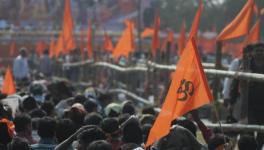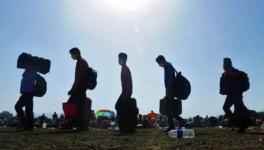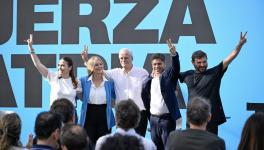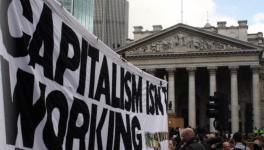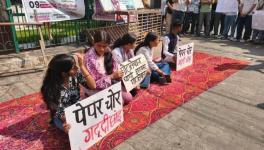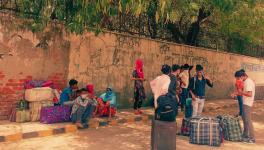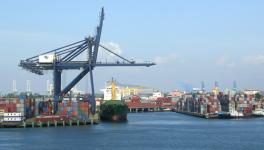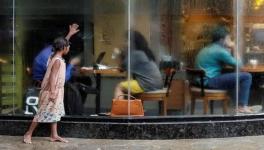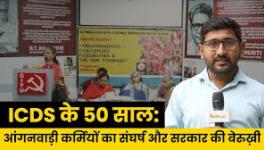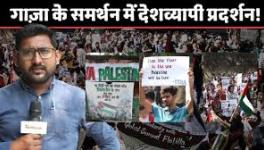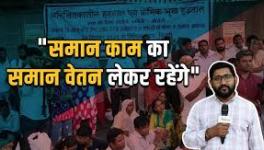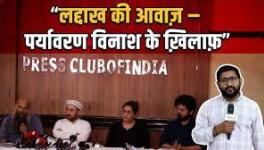Moroccans Take to the Streets in Largest Protests in Years
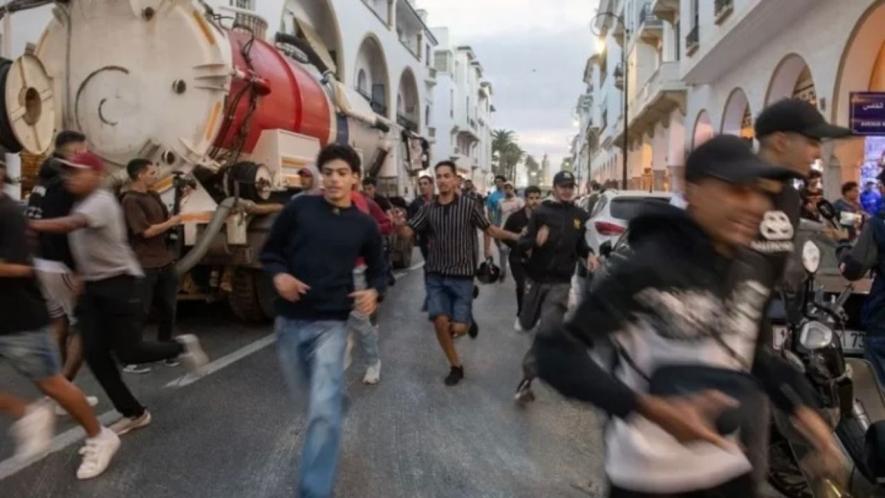
Protesters in Morocco. Photo via Izquierda Diario
Demonstrations swept through 11 cities in Morocco over the weekend, with thousands protesting the government’s corruption and expenditure policies. The government has been slammed for prioritizing international sporting events over basic public services including health care, education, and employment.
What makes these protests different from their predecessors?
Although anti-government protests calling for reform have been on the rise in the Maghreb nation during the past few months, the current rallies are marked by participation of groups representing a wide spectrum of social and political backgrounds, and from different ages.
The voices of students blended together with those of trade unionists, and families, forming a holistic protest scene, and reflecting a unifying spirit. This in turn confirms that daily social justice concerns are not confined to a single group, but is rather a popular demand. However, young “leaderless” organizers calling themselves the Gen Z 212, are believed to have organized the nationwide protests via social media networks.
Who are the Gen Z 212?
Observers suggest that the protesters affiliated with the unclearly-shaped Gen Z 212 movement, are young activists closely connected to the digital world and social media networks, who finally decided to convert their online activism into street demonstrations. According to the available media reports, the Gen Z 212 is a new youth movement, whose emergence coincided with the anti-government protests across Morocco during the last couple of days.
Preliminary information indicate that the Gen Z 212 members do not adhere to a certain political party or ideology, and that their movement was shaped inside virtual online discussion rooms on social media networks including Discord, Instagram, and Tiktok. Meanwhile, the acronym Gen Z is thought to be a connotation of Generation Z, people who were born between late 1990s and 2000s, and who rely heavily on the digital world to express their thoughts and opinions.
Local news website Aldar described the Gen Z 212 as a movement that does not call for its social justice demands beyond national constants, while it explicitly declares its commitment to respecting the royal institution under the leadership of King Mohammad VI, and holding on the Moroccan territorial unity.
This in turn may have given the movement some special legitimacy with the regime, distinguishing it from previous attempts of youth to express their opinion, which often clashed with the political and institutional norm in the country. Nonetheless, around 200 protesters were arrested by the Moroccan authorities over the weekend.
What triggered the weekend protests?
Analysts assert that the current uprising seems to be a sort of continuation of earlier mobilizations against government policies which for years have further deepened inequality in the country, weakening the trust of Moroccan citizens in government promises of reform.
For years, Moroccans have expressed outrage due to the continuous deterioration of the living conditions, the high prices, the public education crisis, and a general sentiment of declining social justice, which block their horizon for a better future.
Building 2030 FIFA World cup stadiums, a major trigger for the protests
Although the unavailability and the poor quality of fundamental public services has been a constant over the last decade, with a recent noticeable increases in unemployment rates and prices, the high expenditure that the government has allocated into building stadiums for the 2030 FIFA World Cup became the straw which broke the camel’s back.
The government is building at least three new stadiums, while renovating or expanding several others to co-host the event in 2030, and the Africa Cup of Nations later this year.
“Stadiums are here, but where are the hospitals?” Say protesters
Voicing their indignation, protesters chanted during demonstrations: “Stadiums are here, but where are the hospitals?” a slogan that reflects the precarious situation of the public healthcare system in the north African country, a prolonged crisis that has become more acute in recent months. This crisis manifested in a shortage in health workers, poor hospital infrastructure, and a delayed response to emergency cases, especially in southern and remote areas.
Morocco’s health sector has been facing an escalating crisis throughout 2025, threatening citizens’ constitutional right to health and life, resulting from poor infrastructure, lack of human resources, and limited funding. Despite increasing the health budget by 65%, from 19.7 billion dirhams in 2021 to 32.6 billion dirhams in 2025, the government’s expenditure on health sector remains low compared to regional standards. Morocco spends around 885 dirhams per capita annually, compared to 2,900 dirhams per capita in Tunisia. The funding gap has led to repeated shortages of essential medicines and medical supplies, which in turn aggravate the suffering of patients, especially the most vulnerable.
Morocco also suffers from a severe shortage of doctors and nurses, with less than 15,000 doctors in the public sector serving over 36 million people. This equals 4 doctors per 10,000 people, which is far below the recommended international rates. A recent study indicates that 95% of citizens faced long waiting periods for healthcare services, while 85% reported lack of medical staff. Another 85% said high costs prevented them from obtaining necessary medications or care. Furthermore, patients needing medical imaging or a test are often referred to high-cost private laboratories because diagnostic equipment in hospitals are either insufficient or not functioning.
This structural crisis has led citizens to protest in several cities, including Agadir, demanding improved healthcare services and access to basic care under the banner “End healthcare neglect”. In Agadir, after several women lost their lives during C-section surgical procedures at the Hassan II Hospital, citizens and civil society members organized protests in front of the hospital, demanding swift investigations and tangible improvements in clinics, emergency services, and equipment.
Broader economic and social demands have been called for by demonstrators nationwide too, including improvements to education and employment.
Education and employment slogans resonate in the streets
Unemployment, especially among educated youth, was also a central motivating issue in the weekend protests. Recently published figures showed that the national economy has been unable to absorb graduates from universities and higher institutes. According to the High Commission for Planning (HCP), the national unemployment rate rose to about 13.3% in 2024, a slight increase compared to the previous year.
The numbers become more alarming among people aged 15–24, with unemployment rates reaching record levels of around 36.7%, meaning more than a third of youth of this age group are directly unemployed. Yet, civil society activists argue that even these figures are misleading. According to the annual report of the Moroccan Association for Human Rights, young people are forced to join the informal sector, described as an “emergency refuge,” which lacks basic elements of decent work and social protection.
The situation of degree holders is another problem that further complicates the economic situation in the country with about 19.6% unemployment rate, confirming a deep structural gap between the educational system’s output and labor market needs.
This contradiction between painstaking efforts and years of study spent by youth on the one hand, and the lack of professional prospects on the other, has provoked public frustration about a bleak future.
Therefore, the core demands of the protestors are not limited to creating job opportunities within the public sector, but working on real, sustainable plans and programs to generate value-added jobs in other productive sectors.
Protesters have also called for combating corruption as it constitutes a major barrier to the fair distribution of job opportunities and wealth, and for implementing accountability and comprehensive financial transparency.
Draft Law No. 59.24 on higher education and scientific research in Morocco, which was submitted to the Moroccan parliament in late September 2025, has further sparked the ire of students and educational unions. Many organizations considered the draft law a regression from the gains of the Moroccan university and a threat to its independence.
The bill has been mainly criticized as it was formulated unilaterally without real involvement of the key stakeholders such as professors and students and was not presented for consultation with them either. Unions and student organizations have raised complaints about the democratic nature of the legislative process.
Particularly, articles 71, 72, and 73 of the draft faced widespread rejection from student bodies. These articles limit the right to organize within university institutions, undermining freedom of expression and political affiliation for students. Furthermore, educational organizations argue that these articles open the door to the privatization of public universities, which would close universities for Moroccan youth from broader society.
The demands of the protests center on guaranteeing free, quality public education for all, calling for comprehensive curriculum reforms to align with modern labor market needs, avoiding overcrowded classrooms, and providing basic infrastructure in rural and remote areas, including dormitories and school transport.
Morocco rises up against exclusion and inequality
The mass protests witnessed on the streets of Morocco, which are likely to continue, did not emerge out of a vacuum, but resulted from historic policies that have contributed to record-high unemployment among youth and deterioration of essential social services including healthcare and education. The extravagant spending on the World Cup and entertainment infrastructure provide a clear picture of the priorities of the state, and its failure to invest in the people and their livelihoods.
Courtesy: Peoples Dispatch
Get the latest reports & analysis with people's perspective on Protests, movements & deep analytical videos, discussions of the current affairs in your Telegram app. Subscribe to NewsClick's Telegram channel & get Real-Time updates on stories, as they get published on our website.









